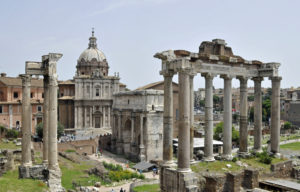
Ruins of Saturn’s Temple in Roman Forum (Photo by Don Knebel)
In about 600 B.C., the fifth King of Rome drained a swampy valley between the Capitoline Hill and the Palatine Hill by diverting the water to the Tiber River in one of history’s first sewer systems. The reclaimed area became the site of the Forum, the center of Rome’s religious and political life. One of the most important buildings in the Forum was a temple dedicated to Saturn, the Roman god of prosperity and fertility. Erected in the fifth century B.C., the temple also served as the city’s treasury and a bank for wealthy Romans. Depositors made sacrifices at the temple in the hope that Saturn would increase their wealth.
Inside the temple was a large wooden image of Saturn. His feet and legs were bound by woolen straps, removed each year at the time of the winter solstice. The unbinding, symbolizing liberation, signaled the beginning of a raucous celebration that began with sacrifices at Saturn’s temple. The celebration, called Saturnalia, continued with gift giving and a temporary suspension of laws governing social behavior. Slaves were given a week of freedom and the right to control their masters. At the beginning of Saturnalia, a man down on his luck was selected as Lord of Misrule to symbolize the turning of society upside down. It was time of drunkenness and permissiveness.
Saturn’s temple was rebuilt in the fourth century after a devastating fire. All that remains from that temple are eight granite columns. But the spirit of the temple may survive in some of the traditions of Christmas, including gift giving, which many scholars believe were adopted from Saturnalia when Christianity became legal in the Roman Empire.
Comments are closed.